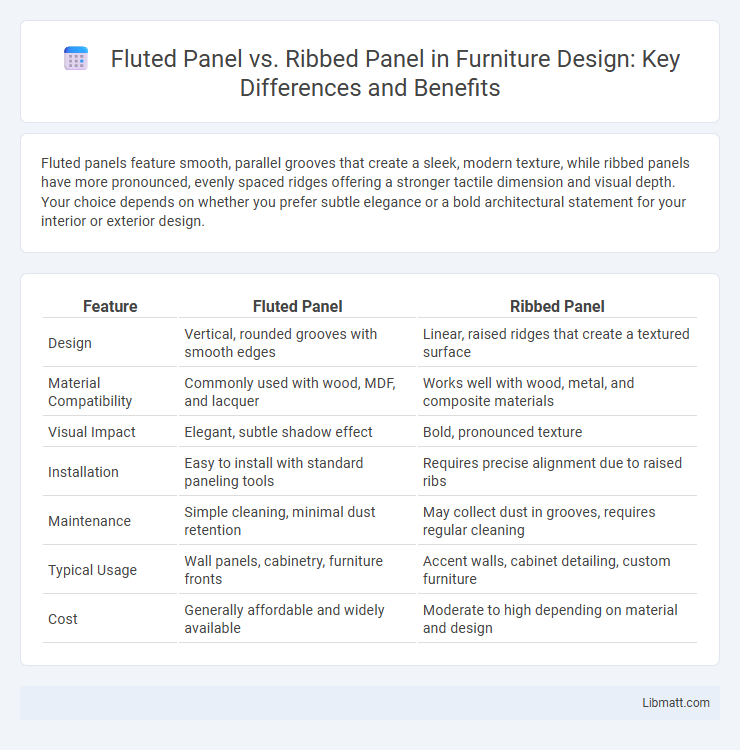Fluted panels feature smooth, parallel grooves that create a sleek, modern texture, while ribbed panels have more pronounced, evenly spaced ridges offering a stronger tactile dimension and visual depth. Your choice depends on whether you prefer subtle elegance or a bold architectural statement for your interior or exterior design.
Table of Comparison
| Feature | Fluted Panel | Ribbed Panel |
|---|---|---|
| Design | Vertical, rounded grooves with smooth edges | Linear, raised ridges that create a textured surface |
| Material Compatibility | Commonly used with wood, MDF, and lacquer | Works well with wood, metal, and composite materials |
| Visual Impact | Elegant, subtle shadow effect | Bold, pronounced texture |
| Installation | Easy to install with standard paneling tools | Requires precise alignment due to raised ribs |
| Maintenance | Simple cleaning, minimal dust retention | May collect dust in grooves, requires regular cleaning |
| Typical Usage | Wall panels, cabinetry, furniture fronts | Accent walls, cabinet detailing, custom furniture |
| Cost | Generally affordable and widely available | Moderate to high depending on material and design |
Introduction to Fluted and Ribbed Panels
Fluted panels feature evenly spaced, vertical grooves that add texture and depth to interior and exterior surfaces, commonly used in modern architectural designs. Ribbed panels have raised ridges running parallel to each other, providing a stronger structural profile and enhanced visual interest, often utilized in commercial building facades and industrial settings. Both panel types enhance aesthetic appeal while offering functional benefits like improved durability and noise reduction.
Defining Features: Fluted vs Ribbed Panels
Fluted panels feature narrow, evenly spaced vertical grooves creating a smooth, linear texture that adds elegance and subtle depth to surfaces. Ribbed panels consist of wider, more pronounced ridges with a stronger three-dimensional effect, offering a bold, tactile architectural element. The primary difference lies in groove width and texture intensity, with fluted panels providing delicate refinement and ribbed panels delivering robust structural emphasis.
Material Options for Fluted and Ribbed Panels
Fluted panels are commonly crafted from materials like wood, MDF, and metal, providing smooth, rounded grooves ideal for elegant, sophisticated interior designs. Ribbed panels, often made from metal, plastic, and composite materials, feature sharp, angular lines that offer a modern, industrial aesthetic with enhanced durability. Your choice between fluted and ribbed panels depends on the desired texture, material flexibility, and the specific architectural style you aim to achieve.
Aesthetic Appeal and Design Versatility
Fluted panels feature narrow, deep grooves that create a sleek, refined texture enhancing modern and minimalist interiors, while ribbed panels offer broader, more pronounced ridges that add boldness and tactile interest ideal for contemporary or industrial designs. The distinct linear patterns of fluted panels provide subtle shadow play and visual rhythm, whereas ribbed panels contribute a stronger three-dimensional effect and dynamic visual weight. Both panel types support versatile applications on walls, ceilings, and furniture, allowing designers to tailor aesthetic appeal based on desired texture depth and stylistic impact.
Installation Process Comparison
Fluted panels feature smooth, narrow grooves that allow for straightforward alignment and attachment to walls using standard mounting hardware, streamlining the installation process for both residential and commercial interiors. Ribbed panels, characterized by their raised, linear ridges, may require precise spacing and additional support to ensure uniformity and stability during installation, often demanding more time and expertise. Both panel types benefit from pre-cut sizes and prefabricated designs, but fluted panels generally allow quicker installation due to their simpler profile and easier handling.
Durability and Maintenance Needs
Fluted panels offer enhanced durability due to their deeper grooves, which resist dents and scratches better than ribbed panels with shallower ridges. Maintenance for fluted panels typically involves less frequent cleaning since their surface design hides dust and minor imperfections more effectively. Your choice between fluted and ribbed panels should consider the durability required for high-traffic areas and the ease of upkeep over time.
Acoustic and Insulation Properties
Fluted panels feature narrow, shallow grooves that enhance sound diffusion and provide moderate acoustic dampening, making them suitable for environments requiring reduced noise levels. Ribbed panels, with their deeper, more pronounced ridges, offer superior insulation properties by trapping air more effectively, resulting in improved thermal and sound insulation performance. Choosing between fluted and ribbed panels influences your space's acoustic comfort and energy efficiency based on the specific design and material density.
Cost Analysis: Fluted vs Ribbed Panels
Fluted panels generally cost more than ribbed panels due to their intricate manufacturing process and premium materials, making them a higher-end choice for architectural applications. Ribbed panels offer a more budget-friendly alternative while maintaining durability and aesthetic appeal, ideal for larger projects requiring cost efficiency. Evaluating your project's budget and design goals will help determine whether the investment in fluted panels justifies the additional expense compared to ribbed panels.
Ideal Applications for Each Panel Type
Fluted panels excel in high-end interior design and architectural finishes, offering a sleek, linear texture ideal for accent walls, ceilings, and cabinetry. Ribbed panels are better suited for industrial and commercial spaces due to their enhanced structural strength and ability to conceal imperfections on exterior facades and storage units. Both panel types contribute distinct aesthetic and functional benefits tailored to residential or commercial environments.
Choosing the Right Panel for Your Project
Fluted panels offer smooth, subtle grooves that create a sleek, modern aesthetic ideal for minimalist interiors, while ribbed panels feature deeper, more pronounced ridges providing a bold, textured look that enhances architectural depth. Selecting the right panel depends on the desired visual impact, with fluted panels suited for elegant, understated designs and ribbed panels for dynamic, tactile surfaces. Consider durability, ease of installation, and compatibility with existing materials to ensure the panel complements both function and style in your project.
Fluted panel vs ribbed panel Infographic

 libmatt.com
libmatt.com